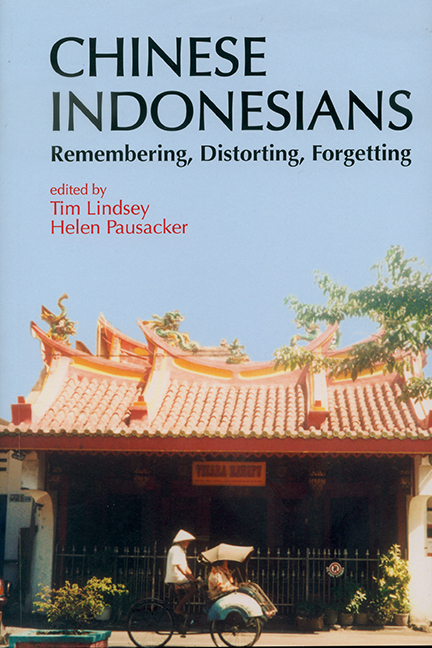Book contents
- Frontmatter
- Contents
- Preface
- A Brief Biography
- Contributors
- Glossary
- Introduction: Researching the Margins
- Bibliography of Charles Coppel's Work
- 1 Anti-Chinese Violence and Transitions in Indonesia: June 1998–October 1999
- 2 Reconstituting the Ethnic Chinese in Post-Soeharto Indonesia: Law, Racial Discrimination, and Reform
- 3 Buddhism and Confucianism in Contemporary Indonesia: Recent Developments
- 4 Portrait of the Chinese in Post-Soeharto Indonesia
- 5 The Makam Juang Mandor Monument: Remembering and Distorting the History of the Chinese of West Kalimantan
- 6 Confucianists and Revolutionaries in Surabaya (c1880–c1906)
- 7 The Chinese and the Early Centuries of Conversion to Islam in Indonesia
- 8 The Agony of Love: A Study of Peranakan Chinese Courtship and Marriage
- 9 Peranakan Chinese and Wayang in Java
- Index
2 - Reconstituting the Ethnic Chinese in Post-Soeharto Indonesia: Law, Racial Discrimination, and Reform
Published online by Cambridge University Press: 21 October 2015
- Frontmatter
- Contents
- Preface
- A Brief Biography
- Contributors
- Glossary
- Introduction: Researching the Margins
- Bibliography of Charles Coppel's Work
- 1 Anti-Chinese Violence and Transitions in Indonesia: June 1998–October 1999
- 2 Reconstituting the Ethnic Chinese in Post-Soeharto Indonesia: Law, Racial Discrimination, and Reform
- 3 Buddhism and Confucianism in Contemporary Indonesia: Recent Developments
- 4 Portrait of the Chinese in Post-Soeharto Indonesia
- 5 The Makam Juang Mandor Monument: Remembering and Distorting the History of the Chinese of West Kalimantan
- 6 Confucianists and Revolutionaries in Surabaya (c1880–c1906)
- 7 The Chinese and the Early Centuries of Conversion to Islam in Indonesia
- 8 The Agony of Love: A Study of Peranakan Chinese Courtship and Marriage
- 9 Peranakan Chinese and Wayang in Java
- Index
Summary
INTRODUCTION
The fall of Soeharto in 1998 was accompanied by calls for radical reform of the oppressive New Order through which he had ruled and, in particular, its legal system. It was also accompanied by attacks on the ethnic Chinese and their property (Coppel 2002, pp. 15–18; Purdey, this volume). These reflected in mob violence a policy of discrimination against this ethnic group that had been institutionalized over the three decades of the New Order.
Since 1998, Indonesia has experienced wide-ranging reform initiatives that have transformed policy, created new state institutions, and introduced a plethora of new regulations. Although the process has been slow, messy, and uneven — and is the subject of harsh criticism, both within Indonesia and internationally — some progress is nonetheless being made (Lindsey 2003). As far as the ethnic Chinese are concerned, however, the extent of this progress remains uncertain at best.
Calls for legal measures to respond to state-sponsored discrimination against, and scapegoating of, the Chinese have contributed to the delivery of important symbolic constitutional amendments; the introduction of sweeping human rights protections against discrimination; the reform of some discriminatory regulations; and a more tolerant state attitude towards ethnic Chinese public cultural expression. Overall, however, change has been limited and superficial. In particular, the state has persistently failed to sanction or even identify the perpetrators of the 1998 violence (Purdey, this volume) and most basic legal mechanisms for anti-ethnic Chinese discrimination — for example, the notorious SBKRI2 system — remain firmly in place.
- Type
- Chapter
- Information
- Chinese IndonesiansRemembering, Distorting, Forgetting, pp. 41 - 76Publisher: ISEAS–Yusof Ishak InstitutePrint publication year: 2005



